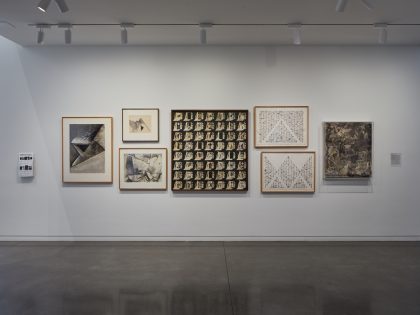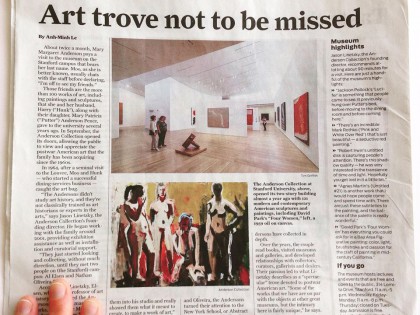Harry W. and Mary Margaret Anderson didn’t know much about art – they’d dabbled in antiques – before they first visited Paris in 1964 and
made their way into the Louvre.
“We became so enamored with the visual experience that on the way home, we looked at each other and said,
‘How could all this have been
going on and we not have been a part of it?’ ” said Harry “Hunk” Anderson.
The museum excursion lasted only half a day, but it turned into a lifetime of collecting art.
Fifty years and about 2,000 acquisitions later,
“Hunk” and “Moo” Anderson – who made their fortune in the food service business – enjoy the
sort of monosyllabic recognition in the American art scene that Sting, Cher and Prince command in pop culture.
Kirk McGuire
Sculpture
kirkmcguire.com
Amazing Bronze Sculptures &
Tables LTD Fine Art &
Furnishings
On Sept. 21, the Anderson Collection at Stanford University will open its doors to the public for the first time. The new campus gallery will
permanently house highlights of the couple’s postwar American art – considered one of the most important collections of its kind in the world –
that have been transferred from the Andersons’ rangy ranch house on the Peninsula.
“When all this leaves,
” Hunk said before the recent move, sweeping a glance around his living room’s chock-a-block walls,
“we may be trying to
replace irreplaceable art with replaceable art,
” meaning no insult to the far less time-tested purchases of younger artists’ works that the couple
continue to make.
Since that day in Paris, Hunk, 91, and Moo, 87, have always approached collecting art as a team. “We’ve all read the same books, we’ve all
looked at the same pictures,
” Moo said,
“and that’s how you get to see things the same way. Hunk and I have never asked one another to give up
and say,
‘I’m going to buy it whether you like it or not.’ There’s too much good art to be had to argue about something that one of us doesn’t
really like.”
Call them Hunk and Moo
At first, some people might feel uncomfortable addressing two of America’s most esteemed contemporary art collectors as Hunk and Moo. But
both of them insist on the monikers – and all who meet the Andersons soon feel that the nicknames fit.
With his brush cut and her aureole of white hair, the longtime Californians make a distinctly Midwestern impression of unaffected openness
and hospitality, though they have roots on the East Coast.
In a multisided conversation, Hunk tends to speak first, but Moo will fill any gaps of hesitation. He paused when they were asked about “the
ones that got away” – artwork they wanted but that eluded them. “Newman got away,
” Moo said promptly, referring to painter Barnett Newman,
whose sudden death in 1970 curtailed his output of large color-field abstractions. “We never found one we wanted that we could afford, and
when we finally found one we wanted, we couldn’t afford it.”
The Andersons’ gift to Stanford of a mere 121 works may not sound like much, but museum directors around the region and the nation have
long salivated at the prospect of receiving even a fraction of what the Andersons call their “core collection.”
It includes not merely good, but supreme, canonical works by giants such as Jackson Pollock, Willem de Kooning, Mark Rothko, Richard
Diebenkorn – and stellar creations by greats perhaps less familiar, such as David Smith, Morris Louis, Philip Guston and Ellsworth Kelly.
58°F San Francisco Search Sign In Register
News Sports Business A&E Food Living Travel Columns Cars Jobs Real Estate Find&Save9/8/2014 Hunk, Moo Anderson give modern art masterpieces to Stanford – SFGate
http://www.sfgate.com/art/article/Hunk-Moo-Anderson-give-modern-art-masterpieces-5740472.php 2/3
Pollock’s abstract “drip painting” “Lucifer” (1947), a capstone of the Anderson Collection and the last great work of its kind in private hands,
might fetch more than $100 million were it to go on the block in today’s overheated auction market.
Opening up their home
Over the years, Hunk and Moo have welcomed countless visitors into their unpretentious home, built in the late 1960s, to view and study their
art. By all accounts, the visitors were uniformly disarmed by the couple’s friendliness, not to mention the jaw-dropping treasures on the walls.
A long, straight hallway in the Andersons’ house connects the entry and living area with the bedrooms. Before the gift to Stanford, man-size
abstract paintings by Philip Guston, William Baziotes and Ellsworth Kelly confronted one another across that corridor, making it impossible for
the collectors and visitors alike to get any viewing distance on them.
“We have never bought a piece about which we said, ‘Oh, it’ll go there,’ ” Moo said. “We buy it and eventually find a place for it.”
The Andersons have plenty of art left to fill the walls of their newly deserted living room and den, but nothing will quite take the place of a
Clyfford Still – bought from the late senior curator of New York’s Museum of Modern Art – so large that it barely fit between floor and ceiling.
The living room once was adorned with a Morris Louis “veil” painting; an early Sam Francis canvas of fluttering red lozenge shapes; a stately
black-on-black square canvas by Ad Reinhardt; and a sculpture in silver, an abstracted clock face, by David Smith.
‘The pick of the litter’
The rapacity of top-tier collectors in the present gilded age effectively makes the market value of the Anderson Collection incalculable. But “for
us, it’s not about how much, but how good,” Hunk said of the family’s acquisitions. “We always want the pick of the litter.”
From the beginning, getting their pick has been a matter of relationships with dealers, fellow collectors and artists.
Their scoring of Pollock’s “Lucifer,” not long after they decided to focus on the so-called New York School, America’s first great art movement,
offers a telling example.
Through fellow collector Eugene V. Thaw, already then renowned as a dealer in old master drawings, they met Andre Emmerich, proprietor of
one of Manhattan’s leading contemporary art galleries. In 1969, Emmerich introduced the Andersons to the owner of “Lucifer,” lawyer and
movie producer Joseph Hazen, who worried the painting wouldn’t fit in his new home. The couple got the anchor of their core collection.
“We paid a record price for it at the time,” Hunk said, characteristically declining to talk figures, but they never regretted the extravagance.
Hunk and Moo’s only child, Mary Patricia Anderson Pence, 54, who goes by the nickname “Putter,” has become her parents’ most important
collaborator in collecting. She grew up with “Lucifer” hanging over her bed.
“One of the great things that’s happened to us as collectors is that this has been a family affair,” said Hunk. “It really has been cementing of
the family.”
It all starts in Geneva
Hunk was born in 1922 in Corning, N.Y., and Moo was born four years later in Newton, Mass. Both went to college in Geneva, N.Y. – Hunk
attended Hobart College on the G.I. Bill after serving in the Army in Burma during World War II, and Moo enrolled at William Smith, the
nearby women’s college.
Hunk owes his name to high school football teammates. Right after Notre Dame’s vaunted coach Knute Rockne was killed in a plane crash in
1931, word got around that Irish assistant coach Heartley “Hunk” Anderson would replace him. A teammate then dubbed him “Hunk”
Anderson, “and I’ve hung onto that tenaciously ever since,” Hunk said.
Moo got her nickname right after the couple met for the first time at the Geneva yacht club.
“Hunk asked me for a date,” Moo said, “and we went down to the hotel saloon in Geneva, and Hunk introduced me as Murma Ransford, which
is what my parents called me. And a guy at the end of the bar said, ‘Moo Moo? What a funny name.’ So we shortened it to Moo.”
During his senior year in college, Hunk and two close friends (who would become his lifelong business partners) sold Hobart College on the idea
of providing its meals for students not living in fraternity houses, a service that was costing the school excessively.
“On Nov. 22, 1948, we opened for the first meal,” Hunk said. “We got 99 students to sign up – $12.50 a week for 18 meals. We opened on
Monday night with a prime rib, and we’d hired a chef – well, a real good cook.”
Their success at Hobart soon led to contracts with William Smith, and then Kalamazoo College in Michigan.
Discovering their passion
Hunk and Moo were married in 1950, and their first 15 years together were consumed with the business and parenthood.
In 1962, Saga partners decided to relocate company headquarters to Menlo Park. By the time the Andersons moved from Oberlin, Ohio, Saga
Foods – as the company came to be called – served 136 institutions and was a financial success.
When the Andersons discovered their passion for collecting in 1964, they started with French and American Impressionists – Claude Monet,
Camille Pissarro, Childe Hassam, Frederick Frieseke – all since sold to free up funds for more adventurous purchases.
“It was an easy way in,” Hunk said.
The designer of the Andersons’ California house, Paul Arnold, thought the couple might need a few pictures to enliven the walls and suggested9/8/2014 Hunk, Moo Anderson give modern art masterpieces to Stanford – SFGate
http://www.sfgate.com/art/article/Hunk-Moo-Anderson-give-modern-art-masterpieces-5740472.php 3/3
an American Impressionist painting titled “4th of July Parade in Walpole, New Hampshire” by Alfred Cornelius Howland. The Andersons
bought it from a jockey who had won the famous quiz show “The $64,000 Question” and retired to open an art gallery in San Francisco.
With the encouragement of Albert Elsen, a Stanford faculty member and a specialist on the sculptor Auguste Rodin, the Andersons began to
study and collect in depth. The pattern gained momentum as they developed friendships with artists whose work they admired, among them
Diebenkorn, Kelly, Guston, Frank Stella, Vija Celmins and Terry Winters.
Over the next two decades, the affluence of the Andersons was enhanced not only by the sale of Saga to the Marriott Corp. in 1986, but also by
their growing art assets.
Longtime supporters of Stanford, the Andersons decided in mid-2011 that the university would receive the cream of their highly coveted
holdings after school President John Hennessy offered to construct a dedicated building for it as part of his campus-wide Arts Initiative.
The Andersons’ affinity for Stanford can be traced not only to the art education they received from historians Elsen and Wanda Corn, but also
because their home and former business headquarters have been neighbors of the campus for nearly 50 years.
Building a ‘golden triangle’
Earlier, the Andersons gave the San Francisco Museum of Modern Art quite a few gifts, most significantly a cluster of works by Jasper Johns,
Andy Warhol, James Rosenquist and others about as definitive of New York’s Pop art moment as any small constellation could be.
The couple also bestowed more than 600 contemporary works in limited editions on the Achenbach Foundation for Graphic Arts, prints and
drawings department of the Fine Arts Museums of San Francisco.
Thinking of their gifts to SFMOMA and the Fine Arts Museums, Hunk said that with the Stanford gift, “we’re building a sort of golden triangle.”
In addition to collecting art, the couple also enjoyed playing tennis – until about five years ago – and still golf.
Commenting on their long life partnership, Hunk said, “There’s obviously been a lot of give-and-take. I’ve had to give and Moo takes.”
Typical of their manner together, Moo greeted the remark with a laugh.
Kenneth Baker is The San Francisco Chronicle’s art critic. Email: kennethbaker@sfchronicle.com Twitter: @kennethbakersf
Welcome to the Anderson Collection
Stanford University's free museum of modern and contemporary American art







